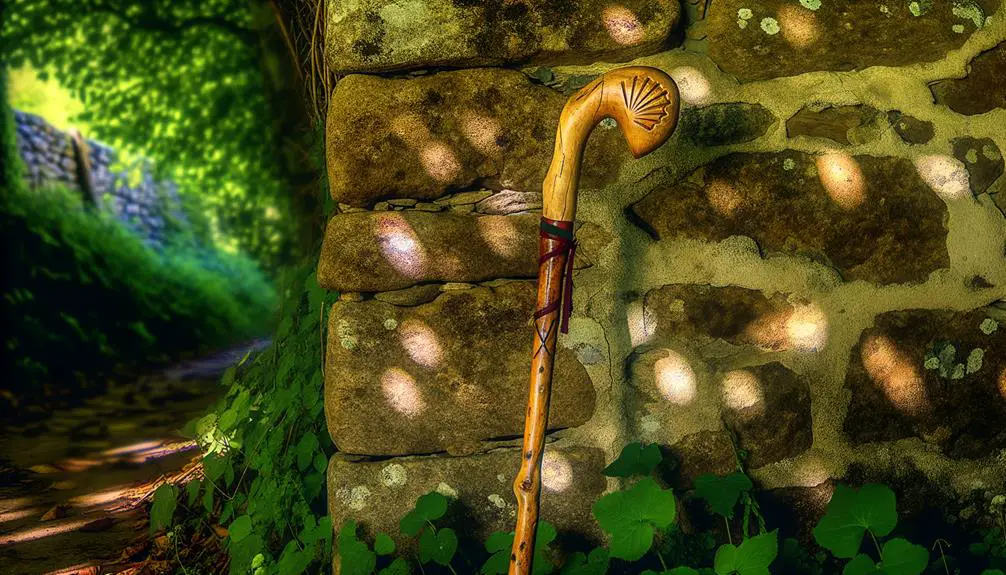Decoding the Camino: Understanding the Meaning of Santiago Symbols
The symbols of the Camino de Santiago are steeped in historical, spiritual, and cultural significance. The scallop shell, a prominent emblem, represents purification and the convergence of various paths leading to Santiago.
Yellow arrows provide clarity and solidarity, guiding pilgrims along their journey. The Cross of St.
James
symbolizes martial valor and divine protection. Pilgrims' tools and items, such as the staff and passport, blend practicality with symbolic meaning, reflecting reliance on divine guidance and commitment.Each symbol contributes to the rich tapestry of the Camino, offering deeper insights into its profound heritage and spiritual journey.

Key Takeaways
- The Scallop Shell signifies purification, spirituality, and the metaphorical convergence of paths.
- Yellow Arrows symbolize guidance, clarity, and solidarity among pilgrims.
- The Cross of St. James reflects martial heritage and divine protection.
- Red Crosses represent faith, dedication, and the spiritual journey linked to Apostle James.
- Milestone Markers provide reassurance and motivation, adorned with symbolic designs.
Scallop Shell

Renowned as a universal emblem of the Camino de Santiago, the scallop shell holds profound historical and symbolic significance for pilgrims.
Historically, the shell served as a practical tool: its shape was ideal for scooping water and food. Symbolically, it embodies themes of pilgrimage and spiritual journey.
The grooves of the shell, converging at a single point, metaphorically illustrate the multitude of paths undertaken by pilgrims, all culminating in Santiago de Compostela.
Additionally, the shell signifies purification, as pilgrims would use it to drink from holy springs along the route. This duality of practical and symbolic utility underscores the shell's enduring presence, reflecting a seamless blend of functionality and deeper spiritual resonance for those on the sacred journey.
Yellow Arrows
The yellow arrows, integral to the Camino de Santiago, trace their origins to the late 20th century when they were first employed by Father Elías Valiña to aid pilgrims in finding the route.
Beyond their practical directional function, these arrows have accrued symbolic weight, representing guidance, perseverance, and communal solidarity among pilgrims.
Examining the historical context, practical applications, and deeper meanings of these arrows reveals their multifaceted significance to the pilgrimage experience.
Origins and History
Tracing back to the early 1980s, the yellow arrows that guide pilgrims along the Camino de Santiago were introduced by Father Elías Valiña, a parish priest from the village of O Cebreiro. This initiative aimed to provide a simple yet effective navigational aid for the growing number of pilgrims starting on this historic journey.
Father Valiña's innovative use of yellow paint, sourced initially from road construction sites, marked a pivotal moment in the modern resurgence of the Camino. His efforts ensured that the path remained accessible, enhancing the pilgrimage experience.
The yellow arrows have since become an enduring symbol, reflecting both the spiritual and practical dimensions of the Camino, and embodying a legacy of hospitality and guidance.
Navigational Significance
Serving as both a practical guide and a symbolic beacon, the yellow arrows along the Camino de Santiago epitomize the convergence of tradition and modernity in pilgrimage navigation. These arrows, strategically placed on rocks, buildings, and signposts, guarantee that pilgrims can traverse the complex routes with minimal difficulty.
Their vivid color and ubiquity make them an intuitive part of the journey, reducing the cognitive load on travelers and enhancing their focus on the spiritual aspects of the pilgrimage. Additionally, the yellow arrows represent a communal effort; they are often maintained by local volunteers and organizations, reflecting a collective commitment to preserving this ancient route.
This navigational aid seamlessly blends ancient traditions with contemporary needs, ensuring the Camino remains accessible to all.
Symbolic Interpretation
Beyond their practical function, the yellow arrows along the Camino de Santiago hold profound symbolic significance, embodying the guiding light that leads pilgrims through both physical terrain and inner spiritual journeys.
These arrows, painted on various surfaces, metaphorically represent clarity amidst confusion and direction in times of doubt. They serve as a reminder of the pilgrim's purpose and the transformative potential of the journey.
The yellow hue, often associated with enlightenment and optimism, underscores the promise of finding one's way. Moreover, the act of following these arrows can be seen as a form of surrender to a higher path, fostering trust and faith in the journey's unfolding.
In this way, the yellow arrows transcend their functional role, becoming emblematic of spiritual guidance and personal growth.
Pilgrim's Staff

The Pilgrim's Staff is a quintessential emblem of the Camino de Santiago. It holds deep historical significance, symbolizing both physical support and spiritual guidance for medieval pilgrims.
Today, its utility persists, albeit with modern adaptations, reflecting a blend of tradition and contemporary practicality. Understanding its evolution from an indispensable travel tool to a symbolic artefact provides insight into the enduring legacy of the Camino pilgrimage.
Historical Significance Explained
Rooted in centuries of tradition, the pilgrim's staff, or 'bordón,' embodies both practical utility and deep symbolic resonance for those journeying along the Camino de Santiago.
Historically, the staff served as an essential tool for navigation, providing support over rugged terrains and protection against wild animals. Beyond its pragmatic functions, the bordón is imbued with profound spiritual significance. It symbolizes the pilgrim's reliance on divine guidance and inner strength, acting as a metaphor for the journey of life and faith.
The staff's presence in medieval iconography underscores its importance, often depicted in the hands of saints and pilgrims, signifying piety, resilience, and the transformative nature of the pilgrimage. This duality of purpose underscores its enduring legacy.
Modern Uses Today
In contemporary times, the pilgrim's rod continues to be an essential companion for modern-day travelers on the Camino de Santiago. It offers both physical support and a tangible connection to the pilgrimage's rich historical and spiritual traditions.
Functionally, the rod aids in maintaining balance on uneven terrain and alleviates pressure on joints during prolonged walking. Symbolically, it serves as a conduit to the medieval pilgrims who set off on this sacred journey, embodying resilience and faith.
Pilgrims often personalize their rods with carvings or mementos, further enhancing its role as a spiritual artifact. By merging practicality with profound symbolic significance, the pilgrim's rod remains a revered and indispensable element of the Camino experience, bridging past and present.
Cross of St. James
How does the Cross of St. James, also known as the Cruz de Santiago, encapsulate the historical and spiritual essence of the Camino de Santiago pilgrimage?
This emblem, distinguished by its sword-like form adorned with a fleur-de-lis, symbolizes both the martial and spiritual heritage of St. James, patron saint of Spain. Historically, it reflects the saint's role in the Reconquista, emblematic of protection and divine intervention.
Spiritually, the cross signifies the pilgrim's journey toward inner transformation and enlightenment, mirroring St. James's own path of faith and martyrdom.
Its pervasive presence along the Camino serves as a constant reminder of the pilgrimage's deeper purpose: a quest for spiritual growth and a connection to a tradition steeped in centuries of devotion.
Pilgrim Passport

The Pilgrim Passport serves as both a practical tool and a symbolic record for those undertaking the Camino de Santiago. By collecting stamps at various stops, pilgrims not only authenticate their journey but also engage with a rich tapestry of cultural and historical significance.
The completion process of this passport is a ritualistic affirmation of one's commitment and perseverance throughout the pilgrimage.
Purpose of Pilgrim Passport
A Pilgrim Passport serves as an essential document for individuals undertaking the Camino De Santiago, providing both a record of their journey and access to accommodations along the route. This credential, imbued with historical and spiritual significance, facilitates the pilgrim's progress through various checkpoints, guaranteeing an authentic pilgrimage experience.
The Pilgrim Passport also:
- Confirms the pilgrim's intent and authenticity.
- Offers access to special pilgrim hostels (albergues).
- Serves as a tool for reflection, documenting each stage of the journey.
- Secures eligibility for the Compostela certificate upon completing the pilgrimage.
- Provides a tangible narrative of the pilgrim's physical and spiritual journey.
Thus, the Pilgrim Passport is indispensable for a structured and verified Camino De Santiago experience.
Stamps and Significance
Integral to the Pilgrim Passport are the stamps collected along the Camino De Santiago, each symbolizing a significant checkpoint and moment of the pilgrim's arduous journey. These stamps, known as “sellos,” are obtained from various locations such as churches, hostels, and cafes, serving both as proof of passage and as mementos of the spiritual and physical milestones achieved. Each stamp not only marks geographic progression but also encapsulates the cultural and historical essence of the locale, fostering a deeper connection to the path traversed. The collection of these stamps transforms the passport into a tangible narrative of the pilgrimage.
| Checkpoint Location | Significance |
|---|---|
| Churches | Spiritual milestones |
| Hostels | Rest and camaraderie |
| Cafes | Local culture |
Passport Completion Process
Completing the Pilgrim Passport requires adherence to specific procedures that authenticate the journey and certify the pilgrim's accomplishments along the Camino De Santiago. This document, known as the 'Credencial del Peregrino,' is essential for anyone wishing to receive the Compostela certificate upon reaching Santiago de Compostela.
To safeguard its authenticity and completeness, pilgrims must follow these guidelines:
- Obtain the passport from authorized locations such as churches, hostels, or pilgrim offices.
- Collect at least two stamps per day from official stops, including accommodations, restaurants, and landmarks.
- Fill in personal details and route information accurately.
- Present the passport at the Pilgrims' Office in Santiago for verification.
- Keep the passport in good condition, as damaged or incomplete passports may invalidate the journey's certification.
This meticulous process solidifies the pilgrim's experience and achievements.
Red Crosses
Red crosses, particularly the Cross of Saint James, hold significant historical and religious connotations along the Camino de Santiago, symbolizing the faith and dedication of pilgrims traversing this ancient route. This emblem, characterized by its distinctive red hue and sword-like shape, has roots in medieval crusades, representing both martyrdom and the spiritual journey undertaken by the faithful.
Its presence on waymarkers, churches, and pilgrim attire underscores its role as a guide and protector, imbuing travelers with a sense of purpose and solidarity. The Cross of Saint James also serves as a visual reminder of the Apostle James the Greater, whose tomb in Santiago de Compostela marks the pilgrimage's destination, intertwining the symbol with the journey's ultimate spiritual fulfillment.
Walking Stick

Often regarded as an essential tool for pilgrims, the walking stick on the Camino de Santiago not only provides physical support but also embodies a deep symbolic significance rooted in tradition and spiritual metaphor. This implement, often carved from sturdy wood, represents the pilgrim's journey, both literal and metaphorical.
- Historical Continuity: Pilgrims have used walking sticks for centuries, symbolizing endurance and perseverance.
- Spiritual Support: The stick is a metaphor for divine guidance and support throughout the arduous journey.
- Practical Utility: It assists in negotiating difficult terrains and provides stability.
- Ritualistic Significance: Often blessed before the journey, it carries spiritual blessings.
- Personal Transformation: The walking stick symbolizes personal growth and the transformative power of the pilgrimage.
Thus, the walking stick is an emblem of the pilgrim's physical and spiritual journey.
Milestone Markers
Just as the walking stick guides and supports the pilgrim, milestone markers play a pivotal role in orienting travelers along the Camino de Santiago, serving as both navigational aids and symbols of progress. These markers, often adorned with shells, crosses, and other emblematic designs, provide reassurance and motivation to pilgrims. Strategically placed, they delineate distances, helping travelers measure their journey both physically and spiritually.
| Symbol | Meaning |
|---|---|
| Shell | Pilgrimage and protection |
| Cross | Faith and spiritual journey |
| Yellow Arrow | Direction towards Santiago |
| Kilometer Stone | Distance remaining to Santiago |
| Stone Mounds | Pilgrim tradition and prayers |
Thus, these markers encapsulate the essence of the Camino, seamlessly blending practical guidance with profound spiritual significance.
Church Symbols
Church symbols along the Camino de Santiago serve as profound emblems of faith, history, and cultural heritage, enriching the pilgrim's journey with layers of spiritual and historical meaning. These sacred symbols, embedded in the architectural fabric of churches, chapels, and cathedrals, offer pilgrims a tangible connection to the divine and a sense of continuity with past generations.
The Cross represents Christ's sacrifice and is central to Christian belief.
The Scallop Shell symbolizes pilgrimage and guidance along the Camino.
The Botafumeiro, a large censer used in the Cathedral of Santiago de Compostela, symbolizes purification.
Iconography of St. James represents the Apostle and the patron saint of pilgrims.
Romanesque and Gothic Architectural Elements demonstrate the historical evolution of religious art.
Each symbol enriches the pilgrimage, offering a deeper understanding of the sacred journey.
Pilgrim's Cape
While traversing the Camino de Santiago, the pilgrim's cape emerges as a multifunctional garment imbued with historical significance and practical utility.
Traditionally, the cape served as a protective layer against the elements, shielding pilgrims from rain, wind, and sun. Symbolically, it represented the humility and simplicity of the pilgrim's journey. Historically, the cape was often adorned with the scallop shell, emblematic of the pilgrimage itself. Its design facilitated easy movement and could double as a blanket during rest periods.
Modern iterations continue to honor these traditions, incorporating lightweight, durable materials suited for long treks. Therefore, the pilgrim's cape not only connects today's travelers with their medieval predecessors but also underscores the enduring themes of resilience and devotion.
Conclusion
In summation, the Camino de Santiago is rich with symbols such as the scallop shell, yellow arrows, and the Cross of St. James, each bearing historical and spiritual significance. These emblems offer pilgrims guidance and inspiration, akin to a medieval GPS system.
The amalgamation of these symbols not only facilitates the journey but also enriches the pilgrim's experience, embedding a deeper connection to the path's storied legacy and the collective pilgrimage tradition.






